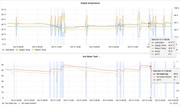I used an iPhone in my boiler and recorded the audio wave form so I could see the time on/off. It is very easy in any audio software to measure time on/off. This only works with an on/off boiler. Ones that modulate the flame up/down wouldn't work for this process. Before hand I set the flow rate as low as it would go which also gave me an idea of which rooms needed radiator improvements. I also left the boiler on continuously for a day to simulate a heat pump. Then I could compare the outside temperature and wind against oil usage. Knowing the nozzle size I could use the manufacturer spec to calculate the oil and therefore energy usage. It was pretty accurate. The main thing I have found is that on the very cold days is generally quite calm and so in an older property you will find the heat pump comfortably heats at much lower outside temperature then the mcs design spec. For example I was aiming for -6 degrees but when we hit-15 a few years ago it was working flat out but keeping up. The thing you need to do then it’s take quick showers to avoid heating water.
I also used the mcs spread sheet to calculate the energy usage s has been mentioned. Before I find the sheet I had also worked it all out from first principles as I am a geek
I am using a 12kW Nibe gshp which maxes out at about 16 amps. Note that often the hot water heating cycle doesn’t use the rates output. For example mine only gets about 6kw average throughout a hot water cycle.
I’d recommend trying out the oil boiler thing as the weather gets colder. It’ll give you a good idea of your pipe work will be able to transfer the heat.
With regards to wbs. We use ours a lot less than we used to. The point of the heat pump is to leave it on all the time. If you the light a stove it gets very unpleasant very quickly in one room. The central thermostat detects the extra heat and the heat pump throttle back. Then a lot of rooms are cold and the one with fire is hot. Take care in placing the thermostat so it isn’t too close to the stove.

